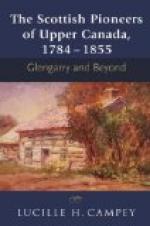[Footnote 3: The Search for the Western Sea, by Lawrence J. Burpee.]
[Illustration: Map of EASTERN CANADA and NEWFOUNDLAND]
The situation was a rather delicate one, for the Hudson’s Bay Company was a thorn in the side of French Canada. However, in this year—1754—the two nations were not actually at war, and the two Frenchmen in charge of the fort received him “in a very genteel manner”, and invited him into their home, where he readily accepted their hospitality. At first they spoke of detaining him till the commandant of the fort returned, but abandoned this idea after reflection, and Hendry continued his journey up the Saskatchewan. He then left the river and marched on foot over the plains which separate the North and the South Saskatchewan Rivers. The South Saskatchewan was found to be a high stream covered with birch, poplar, elder, and fir. He and his Indian guides were searching for the horse-riding Blackfeet Indians.[4] All the Amerindians known to the Hudson’s Bay Company hitherto travelled on foot, using snowshoes in the winter; but vague rumours had reached the Company that in the far south-west there were great nations of Indians which did all their hunting on horseback.
[Footnote 4: See p. 159.]
Hendry had now found them, and he also met a small tribe of Assiniboins—the Mekesue or Eagle Indians—who differed from the surrounding tribes by going about, at any rate in the summertime, absolutely naked. Here, too, between the two Saskatchewans, they saw herds of bison on the plains grazing like English cattle. But they also found elk (moose), wapiti or red deer, hares, grouse, geese, and ducks. He records in his journal: “I went with the young men a-buffalo-hunting, all armed with bows and arrows; killed several; fine sport. We beat them about, lodging twenty arrows in one beast. So expert were the natives that they will take the arrows out of the buffalo when they are foaming and raging with pain and tearing up the ground with their feet and horns until they fall down.” The Amerindians killed far more of these splendid beasts than they could eat, and from these carcasses they merely took the tongues and a few choice pieces, leaving the remainder to the wolves and the grizzly bears.
At last they arrived at the temporary village of the Blackfeet. Two hundred tents or tipis were pitched in two parallel rows, and down this avenue marched Anthony Hendry, gazed at silently by many Blackfeet Indians until he reached the large house or lodge of their great chief, at the end of the avenue of tents. This lodge was large enough to contain fifty persons. The chief received him seated on the sacred skin of a white buffalo. The pipe of peace was then produced and passed round in silence, each person taking a ceremonial puff. Boiled bison beef was then brought to the guests in baskets made of willow branches. Hendry told the great chief of the Blackfeet that he had been sent by the




